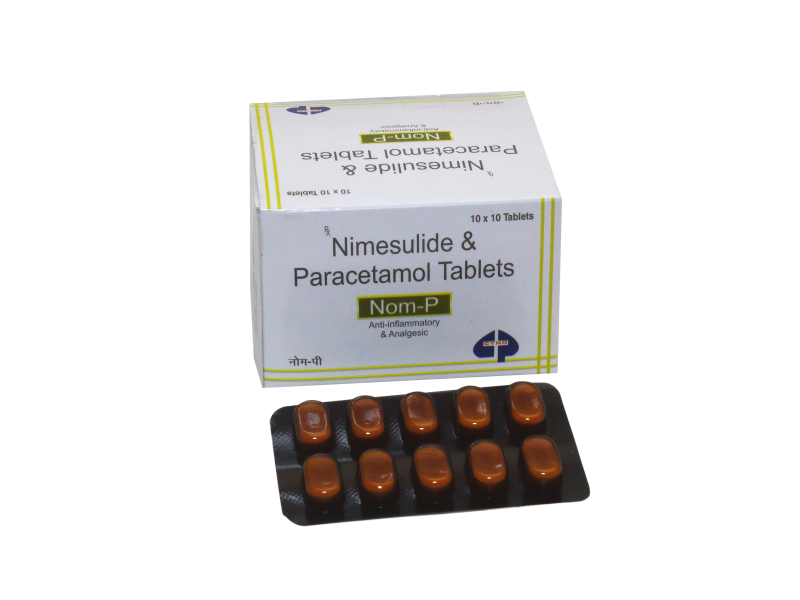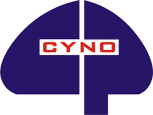NOM P
Nimesulide (100 mg), Paracetamol (325 mg)
NOM P 100 mg tablet is the combination of the two salts nimesulide 100 mg and paracetamol 325 mg that belongs to a group of medicines called nonsteroidal anti-inflammatory drugs (NSAIDs) that helps to reduce the pain and inflammation in conditions such as rheumatoid arthritis, ankylosing spondylitis, osteoarthritis and also relieves fever, muscle pain, back pain, toothache or pain in the ear and throat.
Nimesulide is a painless drug and a non-anti-inflammatory drug with fever-reducing properties. Its accepted indications are the treatment of acute pain, symptomatic treatment of osteoarthritis, and primary dysmenorrhea in adolescents and adults over 12 years of age. Side effects may include liver problems.
Paracetamol, also known as acetaminophen, is a drug used to treat pain and fever. It is commonly used for mild to moderate pain relief. Evidence is mixed for its use for relieving fever in children. It is often sold in combination with other medicines, as in many cold medicines.

Mechanism of Action
NIMESULIDE
This newer NSAID is a relatively weak inhibitor of PG synthesis and there is some evidence to indicate relative COX-2 selectivity. Anti-inflammatory action may be exerted by other mechanisms as well, eg. Reduced generation of superoxide by neutrophils, inhibition of PAF synthesis and TNFα release, free radical scavenging, inhibition of metalloproteinase activity in cartilage.
The analgesic, antipyretic and anti-inflammatory activity of nimesulide has been rated comparable to other NSAIDs.
It has been used primarily for short-lasting painful inflammatory conditions like sports injuries, sinusitis, and other ear-nose-throat disorders, dental surgery, bursitis, low backache, dysmenorrhoea, postoperative pain, osteoarthritis, and fever.
PARACETAMOL – Paracetamol has negligible anti-inflammatory action. It is a poor inhibitor of PG synthesis in peripheral tissues, but more active on COX in the brain. One explanation offered for the discrepancy between its analgesic-antipyretic and anti-inflammatory actions is its poor ability to inhibit COX in the presence of peroxides which are generated at sites of inflammation but are not present in the brain.
Indications:
NOM-P can be used to treat a number of conditions requiring anti-inflammatory, analgesic, antipyretic activities, e.g. osteoarthritis, extra-articular rheumatic diseases, pain and inflammation after the operative intervention and following acute trauma, relief of fever and pain associated with acute respiratory tract inflammation and dysmenorrhea.
Dosage:
Oral dosage form in adults :100 mg b.i.d In children : 5 mg/kg/day in 2 or 3 divided doses.
Oral dosage:
10-12 mg / kg every 4 to 6 hrs.
Pharmacokinetic Properties:
NOM-P is almost completely absorbed orally, 99% plasma protein bound, extensively metabolized, and excreted mainly in urine with a t ½ of 2-5 hours. Paracetamol is well absorbed orally, only about 1/3 is protein-bound in plasma and it is uniformly distributed in the body. It is conjugated with glucuronic acid and sulfate and is excreted rapidly in the urine. Plasma t ½ is 2-3 hours. Effects after an oral dose last 3-5 hours
In contrast to aspirin, paracetamol does not stimulate respiration or affect acid-base balance, does not increase cellular metabolism. It has no effects on CVS. Gastric irritation is insignificant-mucosal erosion and bleeding occur rarely only in overdose.
NOM-P does not affect platelet function or clotting factors and is not uricosuric.
Drug-Drug interactions:
When NOM-P is taken along with Cyclosporine, Digitalis glycosides, Lithium, Methotrexate, Phenytoin there will be elevated serum levels of these drugs and an increased chance of adverse effects.
Precautions:
Those with Alcohol abuse, colitis, crohn’s disease, diverticulitis, gastric ulcer, diabetes mellitus, hemorrhoids, hepatitis, renal disease, rectal irritation or bleeding, systemic lupus erythematosus, and tobacco abuse may have an increased chance of adverse effects.
Fertility:
The use of Nimesulide 100mg Tablets/granules may impair female fertility and is not recommended in women attempting to conceive.
Dosage:
Take the missed dose as soon as you remember. If it is almost the time for your next dose, skip the missed dose. Do not double your dose to make up for the missed one.
Duration of action:
Nimesulide has a relatively rapid onset of action, with meaningful reductions in pain and inflammation observed within 15 minutes from drug intake.
Adverse Reaction:
In isolated antipyretic doses, NOM-P is safe and well-tolerated. Nausea and rashes occur occasionally, leucopenia is rare.
Adverse effects of NOM-P are gastrointestinal (epigastralgia, heartburn, nausea, loose motions), dermatological (rash, pruritus), and central (somnolence, dizziness).
Storage:
Protect from heat and humidity; store at <25°C.
Overdosage:
Seek emergency medical treatment or contact your doctor in case of an overdose.
Contraindications:
NOM-P is contraindicated in hypersensitivity, active peptic ulcer, moderate to severe hepatic disease, and in pregnancy.
Warnings:
Prolonged use can lead to serious complications such as abdominal bleeding and kidney problems. Inform your doctor if you have a history of heart disease or stroke. Avoid consuming alcohol while taking Nimesulide 100mg Tablet as it may increase your risk of stomach problems.
Pregnancy
Can be given- no risks are known in connection with therapeutic doses.
Breastfeeding:
Allowed in therapeutic doses for women who are breast-feeding, only small concentrations in breast milk.
Children:
Well suited
